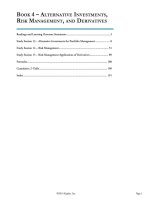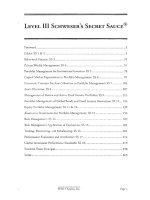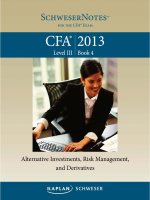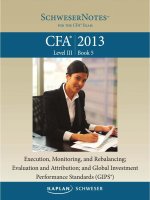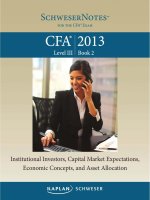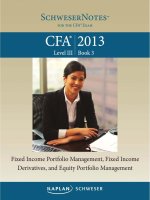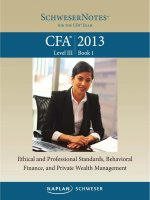2019 CFA level 3 qbank reading 10 managing individual investor portfolios answers
Bạn đang xem bản rút gọn của tài liệu. Xem và tải ngay bản đầy đủ của tài liệu tại đây (1.29 MB, 66 trang )
10/11/2018
Learning Management System
Question #1 of 95
In creating an investment policy statement, a portfolio manager needs to be aware that an
investor's psychological pro le may impact:
A) neither the investor’s risk tolerance nor their return objective.
B) the investor’s risk tolerance and return objective.
C) the investor’s risk tolerance only.
.in
Explanation
bo
ok
c
(Study Session 5, Module 10.1, LOS 10.b)
en
tre
Psychological pro ling is important for understanding individual investor behavior because
defense mechanisms of the brain often cause investors to violate standard nance
assumptions (MPT), resulting in irrational decisions. These psychological tendencies can
impact client preferences, goals and constraints. When constructing an investment policy
statement, these psychological preferences can have a direct impact on a client's willingness
to take risk as well as their desired return.
Related Material
m
SchweserNotes - Book 2
.o
Question #2 of 95
w
w
Which of the following statements about risk and decision-making styles would least likely
appear in a personality typing questionnaire?
w
A) My favorite subject in school was mathematics.
B) I do not like contact sports, like football.
C) I typically lose sleep when the market is down.
Explanation
Most investor questionnaires focus on self-evaluative statements and comments on di erent
non-investment scenarios.
Related Material
SchweserNotes - Book 2
/>
1/66
10/11/2018
Learning Management System
Question #3 of 95
Most of the short questionnaires used by investment professionals to determine client risk
tolerance levels consist of:
A) comments about non-investment scenarios.
B) comments about investment scenarios.
C) questions that focus on how the individual would deal with the professional if
he/she lost their money.
Explanation
Related Material
bo
ok
c
SchweserNotes - Book 2
en
tre
(Study Session 5, Module 10.2, LOS 10.c)
.in
The questions tend to focus on self-evaluative statements and comments on di erent noninvestment scenarios.
An analyst is developing an investment policy statement for Sally Edgewood, a 48-year old
orthodontist with an annual income in excess of $400,000. Edgewood has accumulated an
investment portfolio with a current value of $4 million. Her portfolio is concentrated in small
m
capitalization stocks with a bias toward high-tech companies. She has expressed a desire to
earn a return equal to the return of 12 percent above the return of the Russell 2000 small
.o
capitalization stock index. Edgewood lives well on 50 percent of her annual income. She has
w
w
always been a ski enthusiast and this year she plans to purchase a second home in the
mountains in western Wyoming. This purchase will be mortgaged and require her to make an
$80,000 down payment. Edgewood plans to retire at the age of 63 and is currently paying taxes
w
at a rate of 30 percent on both income and capital gains.
Question #4 of 95
Which of the following most accurately portrays Edgewood's overall risk tolerance? Edgewood's
willingness:
A) and ability to accept risk is above average. Thus, her overall risk tolerance is above
average.
B) to accept risk is above average and her ability to accept risk is average. Thus, her
overall risk tolerance is average.
/>
2/66
10/11/2018
Learning Management System
C) to accept risk is average and her ability to accept risk is above average. Thus, her
overall risk tolerance is average.
Explanation
Edgewood's ability to assume risk is above average as indicated by the fact that her income is
relatively large and exceeds her annual living expenses by a substantial amount. Also, being
invested in small, high tech rms is an indication of Edgewood's above average willingness to
accept risk.
(Study Session 5, Module 10.9, LOS 10.j)
Related Material
Question #5 of 95
en
tre
.in
SchweserNotes - Book 2
Which of the following most accurately describes Edgewood's tax, liquidity, and time horizon
bo
ok
c
constraints? Edgewood's overall time horizon is:
A) long, her tax constraints are signi cant, and her liquidity needs are high.
B) short, her tax constraints are signi cant, and her liquidity needs are low.
m
C) long, her tax constraints are signi cant, and her liquidity needs are low.
Explanation
w
w
.o
Edgewood's overall time horizon is long—25 years or more—and it consists of two states:
pre-retirement and post-retirement. A 30 percent income and capital gains tax is signi cant.
Her liquidity needs are low and can easily be paid out of income.
(Study Session 5, Module 10.9, LOS 10.j)
w
Related Material
SchweserNotes - Book 2
Question #6 of 95
Which of the following sets of assumptions is most relevant to the behavioral nance
investment framework? Investors are:
A) loss averse, investors exhibit biased expectations, investors construct portfolios via
asset segregation.
/>
3/66
10/11/2018
Learning Management System
B) risk averse, investors demonstrate rational expectations with respect to investment
choices, investors construct portfolios consistent with asset integration.
C) risk averse, investors exhibit biased expectations, investors construct portfolios via
asset segregation.
Explanation
Behavioral nance assumes that:
Related Material
Question #7 of 95
bo
ok
c
SchweserNotes - Book 2
en
tre
(Study Session 5, Module 10.1, LOS 10.b)
.in
1. investors are loss averse, which means they prefer uncertain losses to certain losses.
2. investors exhibit biased expectations, due to overcon dence in their ability to forecast
the future.
3. investors construct portfolios via asset segregation, meaning that they tend to focus on
an asset's individual investment features versus its impact on the overall portfolio
position.
Which of the following personality types applies to investors who make investment decisions
m
based on facts as opposed to their feelings or intuitions?
.o
A) Methodical and individualist.
w
w
B) Spontaneous and methodical.
C) Methodical and cautious.
w
Explanation
Methodical investors research markets, industries, and rms for potential investments and
are constantly on a mission to improve their analytical decision-making skills. Individualists
also research their investment opportunities and exhibit independent thought when making
investment decisions. Individualists are very con dent, and this makes them capable of
questioning inconsistencies in either recommendations or conclusions made by others.
Individualist investor types tend to be less risk averse than methodical investors.
(Study Session 5, Module 10.2, LOS 10.c)
Related Material
SchweserNotes - Book 2
/>
4/66
10/11/2018
Learning Management System
Question #8 of 95
Which of the following is NOT determined using situational pro ling? Investor:
A) philosophy.
B) biases.
C) behavior.
Explanation
Situational pro ling does not determine investor behavior, but represents an analysis of
behavior in determining preferences and biases, as well as philosophy.
.in
(Study Session 5, Module 10.1, LOS 10.a)
Related Material
bo
ok
c
Question #9 of 95
en
tre
SchweserNotes - Book 2
Joanne Sparta is a 48-year old, successful physician who earns in excess of $500,000 per year.
She has also been successful speculating on small business startups, which has added an
average of $200,000 to her annual income over the last 10 years. Sparta travels extensively. She
m
likes to consider herself someone who lives in the fast lane and possesses re ned tastes in
.o
both the arts and entertainment. Sparta's annual expenses, including travel and entertainment,
w
w
average $375,000. Sparta has no foreseeable liquidity needs, legal, regulatory, or tax concerns,
and has no unique circumstances. Which of the following most appropriately describes Sparta's
w
ability and willingness to bear risk? Sparta is:
A) neither able or willing to accept risk.
B) willing, but unable to accept risk.
C) both willing and able to accept risk.
Explanation
Based on the information provided, Sparta's fast life style, speculative activities, and relatively
large income in excess of expenses, indicates both a willingness and ability to accept risk.
(Study Session 5, Module 10.9, LOS 10.j)
Related Material
SchweserNotes - Book 2
/>
5/66
10/11/2018
Learning Management System
Question #10 of 95
Although legal and regulatory constraints do not usually impact an individual investor's policy
statement, attention must often be paid between two parties of personal trusts. Which parties
exhibit the greatest tension in setting investment policy for a personal trust?
A) Grantor and remaindermen.
B) Income bene ciary and remaindermen.
C) Income bene ciary and the trust o cer.
.in
Explanation
bo
ok
c
en
tre
A creative tension exists between the income bene ciary and remaindermen listed in a
personal trust. Income bene ciaries would like to have as much current income from the
trust as possible. Remaindermen wish to have as large of a portfolio passed to them after the
income bene ciary dies. The con ict between current income and longer-term portfolio
growth is a situation that must be addressed in formulating investment policy for a personal
trust.
(Study Session 5, Module 10.3, LOS 10.i)
Related Material
.o
m
SchweserNotes - Book 2
w
w
Question #11 of 95
Desired return objectives are those return levels associated with:
w
A) major goals.
B) secondary goals.
C) vacation home goals.
Explanation
Desired return objectives are associated with secondary goals. Desired returns may be
lowered if there is a disconnect between risk tolerance and return objectives.
(Study Session 5, Module 10.6, LOS 10.f)
Related Material
SchweserNotes - Book 2
/>
6/66
10/11/2018
Learning Management System
Question #12 of 95
Tony Mitchell, a college professor, is considering investing in a mutual fund. His number one
priority is long-term capital appreciation. He will take above-average risk in exchange for the
possibility of outperforming the market. Tony is 30 years old and expects to be at the university
until age 70. Which fund is more appropriate for Mitchell given a risk free rate of 3%?
Mutual Fund A
Mutual Fund B
Growth and Income
Five year return 14%
Five year return 12%
Standard deviation = 12
Standard Deviation = 7
Consists of 40% growth stocks,
60% preferred stocks
Consists of 60% growth stocks
and 40% high dividend stocks
bo
ok
c
A) A, because of its higher ve year return.
en
tre
.in
Balanced
B) A, because it has a better risk/return relationship.
C) B, because it has a better risk/return relationship.
Explanation
w
w
.o
m
Fund B is more appropriate because it has a higher mix of growth verses income and its
Sharpe ratio is higher at 1.29 versus Fund A at 0.92. Sharpe ratio A = (14 - 3) / 12 = 0.92,
Sharpe ratio B = (12 - 3) / 7 = 1.29 thus Fund B has a higher return for a given level of risk. It
should be noted that Mitchell should be able to nd another fund to better meet his
objectives (i.e., a growth fund).
(Study Session 5, Module 10.1, LOS 10.b)
w
Related Material
SchweserNotes - Book 2
Question #13 of 95
Gary Daly is a retired schoolteacher who invests most of his money in U.S. Treasury bonds and
notes. He has often stated that in times of crisis, he feels that it is better to be safe than sorry.
In terms of behavioral nance, Daly is exhibiting which personality type?
A) Methodical.
/>
7/66
10/11/2018
Learning Management System
B) Cautious.
C) Spontaneous.
Explanation
Daly's personality type is a "cautious" investor who has a strong desire for nancial security.
Daly is both risk and loss averse and would prefer very safe investments. As such, investors
prefer to rely on their feelings to make important investment decisions.
(Study Session 5, Module 10.2, LOS 10.c)
Related Material
en
tre
.in
SchweserNotes - Book 2
w
w
w
.o
m
bo
ok
c
Question #14 of 95
/>
8/66
10/11/2018
Learning Management System
Given the following investment policy statement, which portfolio allocation would be most
appropriate for Martin and Sheila Torch?
Ability to take risk:
Martin is a pediatrician and has a high level
of income. The high level of income, and
modest size of living expenses compared to
overall assets give the Torch's a high ability
to tolerate risk.
Willingness to take risk:
Objectives
.in
Torch states that he wants to emphasize
protecting the asset base he has built and
does not want the value of his investments
to decline more than 10% in a given year.
Torch's statement implies a low willingness
to take risk.
bo
ok
c
Overall:
en
tre
Risk Tolerance
m
The low willingness to take risk
overshadows the Torch's high ability to take
risk.
w
w
.o
Return
Objectives
w
Constraints
Time Horizon
Liquidity
Requirements
Income requirement in retirement is 2.1%.
Growth requirement including in ation and
meeting gifting goals is 3.8%.
Total after tax return requirement = 5.9%.
Multistage, consisting of 3 time horizons
1. Torch will retire in 5 years.
2. Retirement - at least 20 years.
3. Post retirement - desire to gift assets
at death to children and charities.
Minimal liquidity requirements other than
funding annual living expenses.
Seek legal counsel to create documents to
Legal/Regulatory express the Torch's wishes after their
death.
Taxes
The Torch's are taxable investors in the 35%
/>
9/66
10/11/2018
Learning Management System
tax bracket. Tax aspects of investments
should be considered.
Unique
Considerations
Desire to leave two children and charities a
large estate after the death of Martin and
Sheila.
Expected
Yield
Allocation
1
Allocation
2
Allocation
3
Cash (T-bills)
3.0%
3.0%
5%
5%
10%
Domestic
Bonds
5.5%
5.5%
15%
20%
35%
International
Bonds
6.5%
5.0%
5%
10%
10%
Domestic
Equities
8.0%
2.0%
40%
30%
International
Equities
(Developed)
11.0%
2.5%
10%
20%
10%
Venture Capital
20.0%
0.0%
20%
0%
0%
Real Estate
(REITs)
8.0%
5.0%
5%
5%
5%
10.00%
7.70%
6.78%
2.53%
3.30%
3.83%
0.42
0.52
0.62
w
w
Expected after-tax return
Expected yield
en
tre
w
Sharpe ratio
40%
bo
ok
c
.o
m
Asset Class
.in
Expected
After-tax
Return
A) Allocation 2.
B) Allocation 1.
C) Allocation 3.
Explanation
/>
10/66
10/11/2018
Learning Management System
The Torch's have a required return of 5.9%, so it appears that all of the portfolios will meet
the return requirement. In terms of risk, the Torch's have said that they do not want the
value of their portfolio to decline more than 10% in a single year. Since we have the Sharpe
ratio, return of each portfolio, and the T-bill rate, we can calculate the standard deviation for
each portfolio and calculate the Safety- rst ratio to see if any of the portfolios can be
eliminated.
Standard deviation of Allocation 1 = (10.0 - 3.0) / 0.42 = 16.67%
Standard deviation of Allocation 2 = (7.7 - 3.0) / 0.52 = 9.04%
Standard deviation of Allocation 3 = (6.78 - 3.0) / 0.62 = 6.10%
Safety rst of Allocation 1 = 10.0% - 2(16.67%) = -23.34%
en
tre
Safety rst of Allocation 2 = 7.7% - 2(9.04%) = -10.38%
.in
The safety rst ratio can be calculated as the expected portfolio return minus 2 standard
deviations.
Safety rst of Allocation 3 = 6.78% - 2(6.10%) = -5.42%
Allocation 3 is the only allocation that meets the Torch's goal of not losing more than 10% in
a given year.
bo
ok
c
(Study Session 5, Module 10.8, LOS 10.k)
Related Material
m
SchweserNotes - Book 2
.o
Question #15 of 95
w
w
The results of a personality typing questionnaire can be used to classify investors according to
risk tolerance and how decisions are made. The classi cation that represents the most risk
w
averse investor would be a(an):
A) cautious investor.
B) methodical investor.
C) spontaneous investor.
Explanation
Cautious investors are those investors most averse to portfolio losses. These investors are
the most risk averse investor classi cation and prefer assets with low probability of loss.
(Study Session 5, Module 10.2, LOS 10.c)
Related Material
SchweserNotes - Book 2
/>
11/66
10/11/2018
Learning Management System
Question #16 of 95
Dan Newsmith is 35 and was recently promoted to regional sales manager of a national trading
company. Newsmith has no credit card debt, he does not have an automobile loan, and his
home is mortgage free. Newsmith's salary and bonus more than adequately cover living
expenses. Given this brief pro le, classify Newsmith's ability to tolerate risk when investing
excess funds.
A) Moderate-to-high risk tolerance.
.in
B) Low-to-moderate risk tolerance.
Explanation
en
tre
C) Not enough information to tell.
Newsmith's stage of life (young age) and low requirement for current liquidity (no debts,
living expenses covered) indicate a situational pro le to tolerate moderate-to-high risk.
bo
ok
c
(Study Session 5, Module 10.1, LOS 10.b)
Related Material
m
SchweserNotes - Book 2
.o
Question #17 of 95
w
w
Return requirements are those return levels associated with returns needed to meet:
A) educational goals.
w
B) secondary goals.
C) major goals.
Explanation
Return requirements are returns needed to attain major goals.
(Study Session 5, Module 10.6, LOS 10.f)
Related Material
SchweserNotes - Book 2
/>
12/66
10/11/2018
Learning Management System
Bill Litner, CFA has been hired by Terri c Tires, Inc. (TTI) to counsel TTI's employees concerning
their investments. Jill Fisher is one of the employees and she approaches Litner to help her
manage her personal nances.
Fisher is 36, and earns $30,000 per year from her job at TTI. She rents an apartment, has about
$5,000 in savings, and $3,000 in credit card debt. She is divorced with a 12-year old child and
does not receive alimony or child support. A previous analysis performed by a nancial expert
from the company had predicted that Fisher's de ned bene t pension plan would be able to
support her in her retirement at her current standard of living. TTI's medical coverage is very
good and will cover her in her retirement. Although Fisher has no other source of income, she
recently inherited approximately $2 million in cash from a distant relative, and that is the
.in
reason she has approached Litner.
en
tre
After an initial meeting, Fisher asks Litner to be her investment advisor. As a rst step, Litner
attempts to assess Fisher's personality type with the use of a questionnaire. The questionnaire
indicates that she is conservative in that she will want to know with some certainty the lower
limit of the value of her portfolio in the future. Also, she wants to be informed about every
bo
ok
c
aspect of the investment process, e.g., get detailed information concerning every investment
recommendation that Litner makes for her portfolio before approving it. Part of the
questionnaire attempts to determine how open Fisher is to changes. The questionnaire's
results indicate that she is willing to adjust and sell positions readily, even at a loss, if new
m
information indicates a change is needed.
Litner intends to use the information from the questionnaire to compose an investment policy
.o
statement (IPS). He feels that he should compose the outline of the statement in a consultation
w
w
with Fisher. When Litner asks Fisher to meet with him to compose an IPS, Fisher tells Litner that
she does not see the need for such a statement. She says that she thinks that Litner's
credentials are excellent. Furthermore, since she has indicated that she intends to review in
w
depth all of Litner's recommendations, having such a statement is unnecessary. Litner's
attempts to gather the information he needs through conversations with Fisher go unanswered
and he ends up creating the IPS using the information from the questionnaire Fisher previously
lled out.
Fisher asks Litner to send her information on Litner's rst recommendation for her $2 million
portfolio. She asks that he send to her such information one at a time for her to review so she
can build her portfolio steadily one investment at a time. Fisher tells Litner at the outset that
she wants to avoid frequent rebalancing and turnover because she has heard the costs and tax
consequences of rebalancing and turnover can have a signi cant and negative impact on the
returns of the portfolio.
/>
13/66
10/11/2018
Learning Management System
Question #18 of 95
Litner's insistence on an investment policy statement (IPS) is:
A) not justi ed, and it should be considered optional.
B) justi ed because it is bene cial for both Fisher and Litner.
C) justi ed because it is bene cial for Litner but not necessarily for Fisher.
Explanation
.in
An IPS bene ts both the client and the advisor. For example, it bene ts the client because it
sets guidelines for every recommendation by the advisor and it bene t's the advisor because
it protects the advisor in cases where investments do not perform exactly as expected.
(Study Session 5, Module 10.2, LOS 10.e)
en
tre
Related Material
Question #19 of 95
bo
ok
c
SchweserNotes - Book 2
Given Fisher's age and her source of wealth, Fisher's familiarity with risk taking is:
average level of risk.
m
A) probably high given her lifestyle, and she should be willing to accept a higher than
w
w
of risk.
.o
B) most likely minimal, but she should be willing to accept a higher than average level
C) most likely minimal, and she should be willing to accept a lower than average level
w
of risk.
Explanation
Persons who acquire their wealth through a windfall tend to have minimal familiarity with
risk taking. Given that her age is less than 40, she should be able to accept a higher than
average level of risk.
(Study Session 5, Module 10.2, LOS 10.e)
Related Material
SchweserNotes - Book 2
/>
14/66
10/11/2018
Learning Management System
Question #20 of 95
The use of a questionnaire to assess Litner's personality type is:
A) a standard approach, and Fisher appears to be a spontaneous investor.
B) a standard approach, and Fisher appears to be an anchoring investor.
C) a standard approach, and Fisher appears to be a methodical investor.
Explanation
Such a questionnaire is widely used for just his purpose. Given that Fisher wants to learn
about each investment before she invests indicates she is methodical.
.in
(Study Session 5, Module 10.2, LOS 10.e)
Related Material
bo
ok
c
Question #21 of 95
en
tre
SchweserNotes - Book 2
Fisher's desire to create her portfolio one asset at a time is:
A) not unusual and is indicative of the role of investor psychology in investment
m
choices.
.o
B) very unusual, and indicates that Litner should not take Fisher on as a client.
w
w
C) very unusual, but it is an acceptable method to create a portfolio for an individual
investor, and Litner should follow Fisher's preferences.
w
Explanation
Fisher's desire to compose a portfolio one position at a time is fairly typical of
unsophisticated investors. Litner should try to convince Fisher of the bene ts of taking a
portfolio approach.
(Study Session 5, Module 10.2, LOS 10.e)
Related Material
SchweserNotes - Book 2
Question #22 of 95
/>
15/66
10/11/2018
Learning Management System
Fisher's fear of the costs associated with rebalancing and turnover are:
A) justi ed for both rebalancing and turnover.
B) not justi ed for rebalancing but are justi ed for turnover.
C) justi ed for rebalancing but not for turnover.
Explanation
Rebalancing and turnover can both increase transactions costs and can have unfavorable tax
consequences.
(Study Session 5, Module 10.2, LOS 10.e)
.in
Related Material
en
tre
SchweserNotes - Book 2
Question #23 of 95
bo
ok
c
Litner's use of the questionnaire to create the IPS is:
A) recommended because it allows Litner to assess the accuracy of the information
for consistency.
m
B) one of many appropriate ways for gathering information.
w
w
Explanation
.o
C) not recommended and deemed inappropriate.
w
It is not appropriate to use the personality typing questionnaire to create the IPS because this
type of questionnaire is considered only a rst step in determining the client's risk tolerance
and understanding of the investment decision making process.
(Study Session 5, Module 10.2, LOS 10.e)
Related Material
SchweserNotes - Book 2
Question #24 of 95
Investor psychology indicates investors will form portfolios via which method?
A) Integrating.
/>
16/66
10/11/2018
Learning Management System
B) Triangulating.
C) Pyramiding.
Explanation
Pyramiding is the concept applied to investor portfolio formation in which portfolios are
created by matching layers of assets to speci c goals. Each layer of assets is not particularly
evaluated within an overall portfolio context.
(Study Session 5, Module 10.2, LOS 10.c)
Related Material
en
tre
.in
SchweserNotes - Book 2
Question #25 of 95
Which of the following items is not considered a constraint in constructing an investment policy
bo
ok
c
statement?
A) Taxes.
B) Risk.
C) Liquidity.
m
Explanation
w
w
.o
Risk is an objective, not a constraint in an investment policy statement (IPS). Taxes and
Liquidity are both constraints. An easy way to remember the ve constraints is TTLLU (Time
horizon, Taxes, Liquidity, Legal, Unique).
(Study Session 5, Module 10.2, LOS 10.e)
w
Related Material
SchweserNotes - Book 2
Question #26 of 95
Clients can bene t from an investment policy statement which:
A) provides for legal recourse due to portfolio underperformance.
B) dictates how to spend extra liquidity.
/>
17/66
10/11/2018
Learning Management System
C) provides long-term investment discipline deterring short-term knee-jerk portfolio
adjustments.
Explanation
The purpose of an investment policy statement is to provide long-term discipline in
investment decision making. The investment policy statement protects against short-term
portfolio adjustments resulting from investor panic or overcon dence.
(Study Session 5, Module 10.2, LOS 10.d)
Related Material
.in
SchweserNotes - Book 2
en
tre
Question #27 of 95
Brad Piasecki is a successful 35 year old executive in the technology industry with a company
that is growing rapidly. Piasecki has a pre-tax income of $150,000 per year, and manages to live
bo
ok
c
well below his means. Piasecki is currently saving for both his retirement, which will take place
in 30 years, as well as funding his daughter's college education, which will begin in 15 years.
Piasecki's investment manager has determined that based on contributions to his portfolio,
Piasecki requires at a minimum, an 8 percent annualized return on his investments in order to
m
meet his goals. He also states that Piasecki should invest in a diversi ed stock and corporate
bond portfolio that provides total return with an emphasis on capital gains. When his
.o
investment manager gives Piasecki his recommendations, Piasecki replies "I have seen too
w
w
many of my colleagues buy risky stocks and have their portfolios wiped out. I only want to buy
Treasury bonds for my portfolio."
Piasecki checks the yields on Treasury bonds, and sees that
best yield he can obtain is 4.5 percent. Which of the following would be the best course of
w
action for Piasecki's investment manager?
A) Invest 50 percent in Treasury bonds and 50 percent in the diversi ed
stock/corporate bond portfolio to provide a balance between Piasecki’s risk
l
d
i d
B) Recommend investor education and a reassessment of portfolio objectives since
the investor’s view is inconsistent with his goals and ability to take risk.
C) Invest in the Treasury bonds since willingness to take risk always supersedes ability
to take risk.
Explanation
/>
18/66
10/11/2018
Learning Management System
Given his age, income, and lifestyle, Piasecki would seem to have a high ability to take risk,
which con icts with his willingness to take risk. Also, his required return cannot be achieved
given his willingness to take risk. On the exam, a general rule is to go with client's willingness
to take risk unless doing so would jeopardize the portfolio's ability to meet the investor's
goals (going ahead and investing in the Treasury bonds would not be an option). In this case,
investor education and a reassessment of portfolio objectives is the best option. The client
obviously cannot meet both his return requirement and risk tolerance goals at the same
time, so something has to change – either the client changes his views on risk through
education, or he changes the goals of his portfolio. Taking any of the other two actions would
either not meet the required return, or would violate the risk tolerance, so investor education
is the key. If you see a con ict like this on the exam, make sure the inconsistency is noted and
that you recommend investor education.
(Study Session 5, Module 10.6, LOS 10.h)
.in
Related Material
en
tre
SchweserNotes - Book 2
Jennifer Moore has worked in a governmental position (administrative assistant) since
graduating from high school. She loves her job because she is very good at following her
bo
ok
c
bosses' orders. At o ce functions, many of her colleagues ranted and raved about the quality
of her baked goods. Some even suggested that they tasted so good that she should quit her job
and sell baked goods. Moore is 50 years old and never paid attention to the suggestions of her
m
colleagues. She plans on retiring from the government in three years.
.o
Question #28 of 95
w
w
Based on her personality type, what type of investor is Moore?
A) Individualist.
w
B) Cautious.
C) Methodical.
Explanation
Moore appears to be a cautious investor. She appears unwilling/unsure about making
decisions on her own (following bosses' orders), which goes against the individualist and
methodical investor.
(Study Session 5, Module 10.1, LOS 10.a)
Related Material
SchweserNotes - Book 2
/>
19/66
10/11/2018
Learning Management System
Question #29 of 95
Jennifer Moore recently came into a seven- gure inheritance from a long-lost uncle. Which of
the following statements about Moore is most accurate?
A) Since she didn't count on the inheritance, she will be willing to take on substantial
investment risks.
B) She will be willing to take an active role in the investment process.
C) Moore has little to no familiarity with risk taking and will tend to be more cautious
in her investment approach.
.in
Explanation
(Study Session 5, Module 10.1, LOS 10.a)
SchweserNotes - Book 2
m
Question #30 of 95
bo
ok
c
Related Material
en
tre
Wealth acquired through inheritance could indicate an individual who has less familiarity with
risk taking activity. Given her other personality traits, it appears unlikely that Moore will want
to take an active role in the investment process and/or knowledge. She enjoys taking orders.
.o
Which two constraints greatly impact an individual's investment policy statement?
w
w
A) Time horizon and tax considerations.
B) Legal/regulatory and unique circumstances.
w
C) Legal/regulatory and liquidity concerns.
Explanation
Individual investors have nite lives and are taxable entities. Legal/regulatory factors may
have an impact, but for the most part, individual investors can invest in almost any manner
they please.
(Study Session 5, Module 10.3, LOS 10.i)
Related Material
SchweserNotes - Book 2
/>
20/66
10/11/2018
Learning Management System
Question #31 of 95
Which of the following statements regarding institutional and individual investors is CORRECT?
A) Institutions and not individual investors should focus on total return.
B) Time horizon factors are typically more crucial to individuals than institutions.
C) Portfolio growth is not important when an individual client is faced with substantial
income requirements.
Explanation
(Study Session 5, Module 10.6, LOS 10.g)
SchweserNotes - Book 2
m
Question #32 of 95
bo
ok
c
Related Material
en
tre
.in
Institutions as well as individuals should consider a total return perspective. Spending
objectives usually represent an income component while growth objectives represent a
capital gains component. Even though a client may have a signi cant current income
requirement, attention to portfolio growth is also required. The same is true with respect to
in ation. One of the distinguishing factors between individual and institutional investors is
time horizon. Institutional investors may have in nite lives, but individuals do not.
w
w
A) assimilation.
.o
Focusing on asset-by-asset characteristics is an example of asset:
B) segregation.
w
C) integration.
Explanation
Asset segregation occurs when investors focus on asset-by-asset characteristics rather than
how assets t into an overall portfolio.
(Study Session 5, Module 10.1, LOS 10.b)
Related Material
SchweserNotes - Book 2
/>
21/66
10/11/2018
Learning Management System
Question #33 of 95
Which of the following represents the process involved in creating an investment policy
statement?
A) Evaluate objectives and constraints and combine them with capital market
expectations.
B) Evaluate objectives, capital market expectations, and investment strategies.
C) Determine constraints and formulate investment strategies.
Explanation
Related Material
Question #34 of 95
bo
ok
c
SchweserNotes - Book 2
en
tre
(Study Session 5, Module 10.2, LOS 10.e)
.in
Objectives and constraints are evaluated, and when they are combined with capital market
expectations, the investment policy statement is created.
When constructing an investment policy statement (IPS), which of the following statements
.o
m
would be considered least accurate?
A) If there are liquidity requirements, the applicable after-tax return will need to be
w
w
calculated.
B) The use of total return analysis is almost always the wrong way to approach an IPS.
w
C) One of the distinguishing factors between individual and institutional investors is
time horizon.
Explanation
Use of a total return statement is almost never incorrect. Institutional investors may have
in nite life but individuals do not. The other statements are true statements with respect to
liquidity and time horizon.
(Study Session 5, Module 10.9, LOS 10.j)
Related Material
SchweserNotes - Book 2
/>
22/66
10/11/2018
Learning Management System
Question #35 of 95
The results of a personality typing questionnaire can be used to classify investors according to
risk tolerance and how decisions are made. The classi cation that represents investors
su ering the highest trading costs is:
A) spontaneous investors.
B) methodical investors.
C) individualist investors.
Explanation
(Study Session 5, Module 10.2, LOS 10.c)
SchweserNotes - Book 2
m
Question #36 of 95
bo
ok
c
Related Material
en
tre
.in
Spontaneous investors are those investors desiring to have the latest, hottest investment
idea in their portfolio. Frequent portfolio adjustments and high turnover are characteristics
of investment decisions made by spontaneous investors. High trading costs usually negate
returns generated by the hot ideas.
Which of the following is a reason why psychological pro ling is important for understanding
w
w
.o
individual investor behavior? Investors:
A) focus on individual asset risk/return characteristics as well as how the individual
asset interacts with other assets in the portfolio.
w
B) are assumed to only select portfolios that maximize a return for a given level of
risk.
C) are loss averse.
Explanation
/>
23/66
10/11/2018
Learning Management System
Psychological pro ling is important because investors tend to exhibit certain psychological
characteristics which are not rational and are not consistent with modern portfolio theory.
One of these psychological characteristics is loss aversion, which means that investors would
prefer larger uncertain losses to smaller certain losses (risk seeking behavior). The concept of
loss aversion con icts with the assumption of risk aversion under modern portfolio theory,
which says that investors minimize risk for a given level of return. Note that the other answer
choices are all assumptions under modern portfolio theory (MPT).
(Study Session 5, Module 10.1, LOS 10.b)
Related Material
.in
SchweserNotes - Book 2
en
tre
Question #37 of 95
Which of the following statements about personality typing for individual investors is CORRECT?
A) An ad hoc approach to personality typing is to administer a short questionnaire.
bo
ok
c
B) Subjective assessments of investors are easy to standardize.
C) It is di cult to render precise categorizations of broad groups of investors.
Explanation
.o
m
As opposed to precise categories, broad classi cations are easy to derive. The more
subjective the assessment, the more di cult to standardize. An ad hoc approach would be a
less formal approach based on the investment professional's interview with investors.
(Study Session 5, Module 10.2, LOS 10.c)
w
w
Related Material
w
SchweserNotes - Book 2
Question #38 of 95
Vivian Collins is a client of ESP Financial Advisors. She presents her situation as follows: Collins
is currently a divorced mother to a 5-year-old daughter, Daija. She is 35 years old. She has
worked at her current job with the government for the last 13 years, and assumes that she will
remain there until retirement and collect her pension. Collins wants to be able to send Daija to
the college of her choice. Collins expects her daughter to eventually marry and have children.
She would love to be able to leave something to these future grandchildren. How many time
horizons does Collins have?
/>
24/66
10/11/2018
Learning Management System
A) 4.
B) 3.
C) 5.
Explanation
Collins has 4 distinct time horizons. The rst is now until the time that Daija enrolls in college.
The second is supporting Daija's college education. The third is her remaining years before
retirement and after supporting Daija through college. The fourth is retirement. In retirement
if a goal is to leave some assets to her grandchildren then the portfolio would need to be
managed with that in mind.
(Study Session 5, Module 10.3, LOS 10.i)
.in
Related Material
en
tre
SchweserNotes - Book 2
bo
ok
c
Question #39 of 95
The process of elimination can be used to arrive at an individual's asset allocation. Which of the
following is likely to be the lowest priority in selecting an acceptable portfolio?
B) Sharpe ratio.
w
w
Explanation
.o
C) Liquidity constraint.
m
A) Return objective.
w
Direct violations of explicit return or risk objectives as well as constraints are used to
eliminate unacceptable portfolios. If more than one acceptable portfolio remains, a higher
return to risk ratio could be used. Sharpe is one but not the only such ratio to use. Sharpe is
not necessarily part of the process. Note that if the IPS speci es a minimum Sharpe ratio,
then it would be treated like any other constraint. However that is a special case and the
process of elimination cannot be used if no portfolio is acceptable.
(Study Session 5, Module 10.8, LOS 10.k)
Related Material
SchweserNotes - Book 2
Question #40 of 95
/>
25/66
